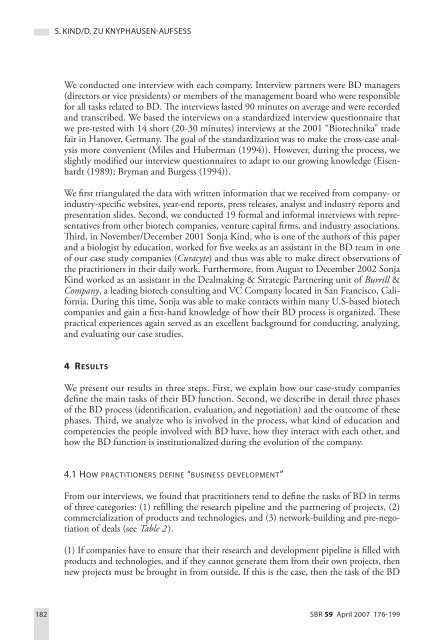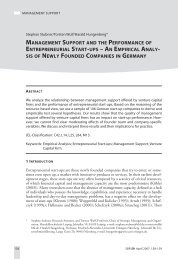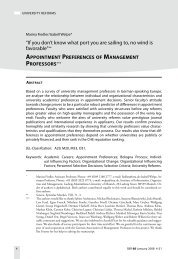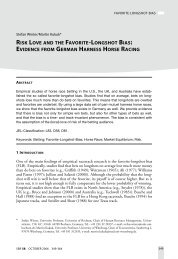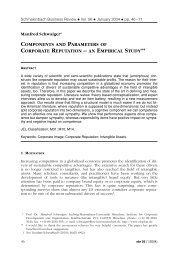“business development”? − the case of biotechnology - sbr ...
“business development”? − the case of biotechnology - sbr ...
“business development”? − the case of biotechnology - sbr ...
You also want an ePaper? Increase the reach of your titles
YUMPU automatically turns print PDFs into web optimized ePapers that Google loves.
S. KIND/D. ZU KNYPHAUSEN-AUFSESS<br />
We conducted one interview with each company. Interview partners were BD managers<br />
(directors or vice presidents) or members <strong>of</strong> <strong>the</strong> management board who were responsible<br />
for all tasks related to BD. Th e interviews lasted 90 minutes on average and were recorded<br />
and transcribed. We based <strong>the</strong> interviews on a standardized interview questionnaire that<br />
we pre-tested with 14 short (20-30 minutes) interviews at <strong>the</strong> 2001 “Biotechnika” trade<br />
fair in Hanover, Germany. Th e goal <strong>of</strong> <strong>the</strong> standardization was to make <strong>the</strong> cross-<strong>case</strong> analysis<br />
more convenient (Miles and Huberman (1994)). However, during <strong>the</strong> process, we<br />
slightly modifi ed our interview questionnaires to adapt to our growing knowledge (Eisenhardt<br />
(1989); Bryman and Burgess (1994)).<br />
We fi rst triangulated <strong>the</strong> data with written information that we received from company- or<br />
industry-specifi c websites, year-end reports, press releases, analyst and industry reports and<br />
presentation slides. Second, we conducted 19 formal and informal interviews with representatives<br />
from o<strong>the</strong>r biotech companies, venture capital fi rms, and industry associations.<br />
Th ird, in November/December 2001 Sonja Kind, who is one <strong>of</strong> <strong>the</strong> authors <strong>of</strong> this paper<br />
and a biologist by education, worked for fi ve weeks as an assistant in <strong>the</strong> BD team in one<br />
<strong>of</strong> our <strong>case</strong> study companies (Curacyte) and thus was able to make direct observations <strong>of</strong><br />
<strong>the</strong> practitioners in <strong>the</strong>ir daily work. Fur<strong>the</strong>rmore, from August to December 2002 Sonja<br />
Kind worked as an assistant in <strong>the</strong> Dealmaking & Strategic Partnering unit <strong>of</strong> Burrill &<br />
Company, a leading biotech consulting and VC Company located in San Francisco, California.<br />
During this time, Sonja was able to make contacts within many U.S-based biotech<br />
companies and gain a fi rst-hand knowledge <strong>of</strong> how <strong>the</strong>ir BD process is organized. Th ese<br />
practical experiences again served as an excellent background for conducting, analyzing,<br />
and evaluating our <strong>case</strong> studies.<br />
4 RESULTS<br />
We present our results in three steps. First, we explain how our <strong>case</strong>-study companies<br />
defi ne <strong>the</strong> main tasks <strong>of</strong> <strong>the</strong>ir BD function. Second, we describe in detail three phases<br />
<strong>of</strong> <strong>the</strong> BD process (identifi cation, evaluation, and negotiation) and <strong>the</strong> outcome <strong>of</strong> <strong>the</strong>se<br />
phases. Th ird, we analyze who is involved in <strong>the</strong> process, what kind <strong>of</strong> education and<br />
competencies <strong>the</strong> people involved with BD have, how <strong>the</strong>y interact with each o<strong>the</strong>r, and<br />
how <strong>the</strong> BD function is institutionalized during <strong>the</strong> evolution <strong>of</strong> <strong>the</strong> company.<br />
4.1 HOW PRACTITIONERS DEFINE “BUSINESS DEVELOPMENT”<br />
From our interviews, we found that practitioners tend to defi ne <strong>the</strong> tasks <strong>of</strong> BD in terms<br />
<strong>of</strong> three categories: (1) refi lling <strong>the</strong> research pipeline and <strong>the</strong> partnering <strong>of</strong> projects, (2)<br />
commercialization <strong>of</strong> products and technologies, and (3) network-building and pre-negotiation<br />
<strong>of</strong> deals (see Table 2 ).<br />
(1) If companies have to ensure that <strong>the</strong>ir research and development pipeline is fi lled with<br />
products and technologies, and if <strong>the</strong>y cannot generate <strong>the</strong>m from <strong>the</strong>ir own projects, <strong>the</strong>n<br />
new projects must be brought in from outside. If this is <strong>the</strong> <strong>case</strong>, <strong>the</strong>n <strong>the</strong> task <strong>of</strong> <strong>the</strong> BD<br />
182 SBR 59 April 2007 176-199


